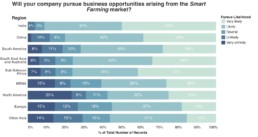Farmers have always used information about wind and weather to know when to plant and harvest. Recent development and dissemination of advanced technological tools at an affordable price have resulted in both large and small-scale farmers having new and more precise tools to produce more with less.
Farming takes skills. You have to know when to plant, when to water, when to fertilise and when to harvest. You need to know how to protect your crop from pests and from spoiling after harvest, and you need to know what the proper price is for your produce. Luckily, farmers worldwide are facing a suite of technological advances that can assist them in growing more food and bring more of it to market at a fair price. The opportunity for making farming smarter can increase yields and profits and reduce the use of precious water and fertiliser.

A Farmer’s Most Valuable Tool: The Phone
The phone is the new agricultural tool. The fast growing access to communication services also for smallholders offers a range of benefits to farmers. Better weather and climate data will help planning which crops to plant, when to harvest etc. Moreover, with a phone in hand, even small-scale farmers can connect to new customers who were previously unreachable giving them greater power in the marketplace. This kind of knowledge was previously the reserve of farmers on modernized agricultural production units but can now be available to a much wider group.
Growing More With Less
Another set of advances that can aid farmers globally is precision farming. It is techniques ranging from relatively simple and affordable drip watering to advanced hydroponics which allows farmers to target water and fertilizer precisely when and where plants need it. Rising prices for agricultural inputs like water and fertilizers are fuelling the development of smart farming technologies and techniques to produce more with less. Some countries regulate water and fertilizers use on farms, which in turns drives the uptake of precision farming practices. As an added benefit, targeting fertilizer to where it is most needed can significantly reduce greenhouse gas emissions from farming currently amounting to between one-fifth and one-third of greenhouse gases emissions.
Combined with the advent of big data, these technologies are likely to generate novel applications in the future, potentially showing great relevance to the challenge of efficiently managing medical records and creating more transparent and patient-centered healthcare. Coupled with accelerating rates of high-speed network coverage and rapidly decreasing hardware costs, mHealth approaches to combatting NCDs are becoming uniquely positioned to provide life-saving information and services to all.
Smart Urban Farming
Smart farming is also an opportunity in cities. In urban areas, lack of vacant plots of land is driving more and more urban farmers to produce food upwards on the side of buildings rather than outwards. This vertical farming is a spatially efficient option for urban food production, which can be made smart by the use of information technology to time and target inputs. Even today, urban agriculture produces 15 to 20 percent of the world’s food supply and plays a major role in global food security. Most urban farming is placed in low income areas, adding directly to food security of the poorest part of global population. Urban farming can be made smart through the use of information technology to increase yields. This smart farming opportunity can benefit from the development of a variety of different types of technologies e.g. analytics solutions, sensors, soft- and hardware systems and positioning technologies. If successful, it has the potential to increase agricultural production, improve small farmers’ competiveness and provide a growing urban population with fresher produce.
Survey Findings
A phone, a robot and/or a computer are the new farming tools alongside the hoe and the tractor. Farmers everywhere use technology to produce more with less and to make resources last. “Smart Farming” is a globally applicable tool box adaptable to different contexts. It is smart farming and good business.

In our 2015 survey, Smart Farming was the favorite of all fifteen opportunities on the overall opportunity ranking across all regions. This opportunity deviates from the overall trend of low political will power to pursue opportunities as it is perceived to be backed by political will power. All regions are also in general perceived to be equipped to implement it both in terms of technology and economic capacity. There are some exceptions to this trend as North America shows to have low perceived political will power to pursue the opportunity.
There seems to be a high degree of consensus among the different HDI groups, as the market opportunity is very popular for medium HDI, high HDI as well as the very high HDI countries. Respondents in the age range between 30 and 50 years see “Smart Farming” very optimistically, while the young respondents below the age of 30 are less attracted by it.

For all the assessed business sectors the message is clear that smart farming will affect their business. However, only respondents from the service sector state to be more likely to pursue this opportunity than on average for all the other opportunities. The opportunity is a preferred opportunity for the governmental and other business sector.
This market was surveyed globally in 2015 by more than 5500 leaders from both the public and private sectors. The survey was conducted in collaboration with the research company YouGov. The survey results were originally published in the Global Opportunity Report 2016.

